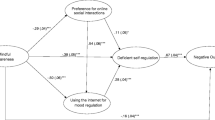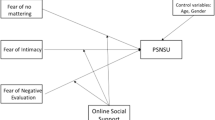Abstract
Social Anxiety Disorder (SAD) is a prevalent mental health issue and has been reliably associated with problematic internet use (PIU), an escalating concern. The aim of this study was to evaluate the impact of two theoretically derived internet affordances—seeking social connections online and safety-seeking behaviors online—in this relationship, and to compare their relative impact. Using a sample of 537 adult volunteers and self-report measures, we tested a structural equation model to probe their contributions. Results indicate that individuals with more SAD symptoms tended to use the internet more for both internet affordances, which in turn increased the likelihood of PIU. The relative contribution of safety behaviors in the relationship between SAD and PIU was five times stronger than seeking social connections online. We discuss our results in the context of an affordance-based approach to research internet behaviors and delve into potential clinical implications.

Similar content being viewed by others
Data availability
The data for this manuscript is available in its anonymized form at the following link: https://osf.io/9xwu3/?view_only=5ebb24e3317d4722845a49bb814154ad.
References
American Psychiatric Association (1987). Diagnostic and statistical manual of mental disorders (3th ed., rev.) Washington, DC: Author.
American Psychiatric Association. (2013). Diagnostic and statistical manual of mental disorders ( (5th ed.). Author.
Asher, M., & Aderka, I. M. (2018). Gender differences in social anxiety disorder. Journal of Clinical Psychology, 74(10), 1730–1741. https://doi.org/10.1002/jclp.22624.
Boyers, G. B., Broman-Fulks, J. J., Valentiner, D. P., McCraw, K., Curtin, L., & Michael, K. D. (2017). The latent structure of social anxiety disorder and the performance only specifier: A taxometric analysis. Cognitive Behaviour Therapy, 46(6), 507–521. https://doi.org/10.1080/16506073.2017.1338310.
Brown, O., Smith, L. G. E., Davidson, B. I., & Ellis, D. A. (2022). The problem with the internet: An affordance-based approach for psychological research on networked technologies. Acta Psychologica, 228, 103650. https://doi.org/10.1016/j.actpsy.2022.103650.
Chan, D. (2009). So why ask me? Are self-report data really that bad? In C. E. Lance & R. J. Vandenberg (Eds.), Statistical and methodological myths and urban legends: Received doctrine, verity, and fable in the organizational and social sciences: (311–338). New York: Routledge.
Clark, D. M. (2001). A cognitive perspective on social phobia. In W. R. Crozier, & L. E. Alden (Eds.), International handbook of social anxiety: Concepts, research and intervention relating to the self and shyness (pp. 405–430). Wiley, Ltd.
Clark, D., & Beck, A. (2012). Terapia Cognitiva para Los trastornos de ansiedad. Desclée de Brouwer.
Clark, D. M., & McManus, F. (2002). Information processing in social phobia. Biological Psychiatry, 51(1), 92–100. https://doi.org/10.1016/s0006-3223(01)01296-3.
Coan, J. A., & Sbarra, D. A. (2015). Social Baseline Theory: The Social Regulation of Risk and Effort. Current Opinion in Psychology, 1, 87–91. https://doi.org/10.1016/j.copsyc.2014.12.021.
Cohen, J. (1988). Statistical Power Analysis for the behavioral sciences (2nd ed.). Lawrence Erlbaum Associates,.
R Core Team (2021). R: A language and environment for statistical computing. R Foundation for Statistical Computing, Vienna, Austria. URL https://www.R-project.org/.
De la Rubia, J. M., García Cadena, C. H., & Antona Casas, C. J. (2013). Validación de la escala de ansiedad en la interacción social en estudiantes universitarios mexicanos. Pensamiento Psicológico, 11(1), 27–42. https://revistas.javerianacali.edu.co/index.php/pensamientopsicologico/article/view/486/419.
Di Stefano, C., & Morgan, G. B. (2014). A Comparison of Diagonal Weighted Least Squares Robust Estimation Techniques for Ordinal Data. Structural Equation Modeling: A Multidisciplinary Journal, 21(3), 425–438. https://doi.org/10.1080/10705511.2014.915373.
Gibson, J. J. (1986). The ecological approach to visual perception. Lawrence Erlbaum Associates, Inc. (Original work published 1979).
Griffiths, M. D. (2018). Conceptual issues concerning internet addiction and internet gaming disorder. International Journal of Mental Health and Addiction, 16(1), 233–239. https://doi.org/10.1007/s11469-017-9818-z.
Guillemin, F., Bombardier, C., & Beaton, D. (1993). Cross-cultural adaptation of health-related quality of life measures: Literature review and proposed guidelines. Journal of Clinical Epidemiology, 46(12), 1417–1432. https://doi.org/10.1016/0895-4356(93)90142-n.
Günther, V., Kropidlowski, A., Schmidt, F. M., Koelkebeck, K., Kersting, A., & Suslow, T. (2021). Attentional processes during emotional face perception in social anxiety disorder: A systematic review and meta-analysis of eye-tracking findings. Progress in Neuro-Psychopharmacology & Biological Psychiatry, 111, 110353. https://doi.org/10.1016/j.pnpbp.2021.110353.
Hernández, C., & Rivera, D. (2018). Adaptación Transcultural y Evaluación de las Estructuras Factoriales del Test de Adicción a Internet en Chile: Desarrollo de una Versión Abreviada. Revista Iberoamericana de Diagnóstico y Evaluación – e Avaliação Psicológica, 49(4). https://doi.org/10.21865/RIDEP49.4.12
Hernández, C., Cottin, M., Parada, F., Labbé, N., Núñez, C., Quevedo, Y., & Behn, A. (2022). Watching the world from my screen: A longitudinal evaluation of the influence of a problematic use of the internet on depressive symptomatology. Computers in Human Behavior, 126, 106995. https://doi.org/10.1016/j.chb.2021.106995.
Hofmann, S. G., Hayes, S. C., & Lorscheid, D. N. (2021). Learning process-based therapy: A skills training manual for targeting the core processes of psychological change in clinical practice. New Harbinger.
Hu, L., & Bentler, P. M. (1999). Cutoff criteria for fit indexes in covariance structure analysis: Conventional criteria versus new alternatives. Structural Equation Modeling, 6(1), 1–55. https://doi.org/10.1080/10705519909540118.
Hussain, Z., & Griffiths, M. D. (2018). Problematic social networking Site Use and Comorbid Psychiatric disorders: A systematic review of recent large-scale studies. Frontiers in Psychiatry, 9, 686. https://doi.org/10.3389/fpsyt.2018.00686.
Kamalou, S., Shaughnessy, K., & Moscovitch, D. A. (2019). Social anxiety in the digital age: The measurement and sequelae of online safety-seeking. Computers in Human Behavior, 90, 10–17. https://doi.org/10.1016/j.chb.2018.08.023.
Kardefelt-Winther, D. (2014). A conceptual and methodological critique of internet addiction research: Towards a model of compensatory internet use. Computers in Human Behavior, 31, 351–354. https://doi.org/10.1016/j.chb.2013.10.059.
Kim, D., Kang, H. Y., & Ahn, J. K. (2022). The relationship between three subtypes of safety behaviors and social anxiety: Serial mediating effects of state and trait post-event processing. Frontiers in Psychology, 13(November), 1–10. https://doi.org/10.3389/fpsyg.2022.987426.
Klein, A. M., Liber, J. M., van Lang, N. D. J., Reichart, C., Nauta, M., van Widenfelt, B. M., & Utens, E. M. W. J. (2021). The role of Social skills in Predicting Treatment-Recovery in Children with a social anxiety disorder. Research on Child and Adolescent Psychopathology, 49(11), 1461–1472. https://doi.org/10.1007/s10802-021-00824-x.
Lee, B. W., & Stapinski, L. A. (2012). Seeking safety on the internet: Relationship between social anxiety and problematic internet use. Journal of Anxiety Disorders, 26(1), 197–205. https://doi.org/10.1016/j.janxdis.2011.11.001.
McLean, C. P., Asnaani, A., Litz, B. T., & Hofmann, S. G. (2011). Gender differences in anxiety disorders: Prevalence, course of illness, comorbidity and burden of illness. Journal of Psychiatric Research, 45(8), 1027–1035. https://doi.org/10.1016/j.jpsychires.2011.03.006.
Naidu, S., Chand, A., Pandaram, A., & Patel, A. (2023). Problematic internet and social network site use in young adults: The role of Emotional Intelligence and fear of negative evaluation. Personality and Individual Differences, 200, 111915. https://doi.org/10.1016/j.paid.2022.111915.
O’Day, E. B., & Heimberg, R. G. (2021). Social media use, social anxiety, and loneliness: A systematic review. Computers in Human Behavior Reports, 3, 100070. https://doi.org/10.1016/j.chbr.2021.100070.
Pan, Y. C., Chiu, Y. C., & Lin, Y. H. (2020). Systematic review and meta-analysis of epidemiology of internet addiction. Neuroscience and Biobehavioral Reviews, 118, 612–622. https://doi.org/10.1016/j.neubiorev.2020.08.013.
Peters, L., Sunderland, M., Andrews, G., Rapee, R. M., & Mattick, R. P. (2012). Development of a short form Social Interaction anxiety (SIAS) and Social Phobia Scale (SPS) using nonparametric item response theory: The SIAS-6 and the SPS-6. Psychological Assessment, 24(1), 66–76. https://doi.org/10.1037/a0024544.
Preacher, K. J. (2015). Advances in mediation analysis: A survey and synthesis of new developments. Annual Review of Psychology, 66(1), 825–852. https://doi.org/10.1146/annurev-psych-010814-015258.
Prizant-Passal, S., Shechner, T., & Aderka, I. M. (2016). Social anxiety and internet use–A meta-analysis: What do we know? What are we missing? Computers in Human Behavior, 62, 221–229. https://doi.org/10.1016/j.chb.2016.04.003.
Rodgers, R. F., Mclean, S. A., Gordon, C. S., Slater, A., Marques, M. D., Jarman, H. K., & Paxton, S. J. (2020). Development and Validation of the Motivations for Social Media Use Scale (MSMU) Among Adolescents. Adolescent Res Rev 6, 425–435 (2021). https://doi.org/10.1007/s40894-020-00139-w.
Ropovik, I., Martončik, M., Babinčák, P., Baník, G., Vargová, L., & Adamkovič, M. (2023). Risk and protective factors for (internet) gaming disorder: A meta-analysis of pre-COVID studies. Addictive Behaviors, 139, 107590. https://doi.org/10.1016/j.addbeh.2022.107590.
Rosseel, Y. (2012). Lavaan: An R Package for Structural equation modeling. Journal of Statistical Software, 48(2), 1–36. http://www.jstatsoft.org/v48/i02/.
Sharpe, L., Todd, J., Scott, A., Gatzounis, R., Menzies, R. E., & Meulders, A. (2022). Safety behaviours or safety precautions? The role of subtle avoidance in anxiety disorders in the context of chronic physical illness. Clinical Psychology Review, 92, 102126. https://doi.org/10.1016/j.cpr.2022.102126.
Stein, M. B., & Stein, D. J. (2008). Social anxiety disorder. Lancet (London England), 371(9618), 1115–1125. https://doi.org/10.1016/S0140-6736(08)60488-2.
Stein, D. J., Lim, C., Roest, A. M., de Jonge, P., Aguilar-Gaxiola, S., Al-Hamzawi, A., Alonso, J., Benjet, C., Bromet, E. J., Bruffaerts, R., de Girolamo, G., Florescu, S., Gureje, O., Haro, J. M., Harris, M. G., He, Y., Hinkov, H., Horiguchi, I., Hu, C., Karam, A., & WHO World Mental Health Survey Collaborators. (2017). The cross-national epidemiology of social anxiety disorder: Data from the World Mental Health Survey Initiative. BMC Medicine, 15(1), 143. https://doi.org/10.1186/s12916-017-0889-2.
Withagen, R., de Poel, H. J., Araújo, D., & Pepping, G. (2012). Affordances can invite behavior: Reconsidering the relationship between affordances and agency. New Ideas in Psychology, 30(2), 250–258. https://doi.org/10.1016/j.newideapsych.2011.12.003.
Wong, J., Gordon, E. A., & Heimberg, R. G. (2014). Cognitive-behavioral models of social anxiety disorder. In J. W. Weeks (Ed.), The Wiley Blackwell handbook of social anxiety disorder (pp. 3–23). Wiley Blackwell. https://doi.org/10.1002/9781118653920.ch1.
Yen, J. Y., Yen, C. F., Chen, C. S., Wang, P. W., Chang, Y. H., & Ko, C. H. (2012). Social anxiety in online and real-life interaction and their associated factors. Cyberpsychology Behavior and Social Networking, 15(1), 7–12. https://doi.org/10.1089/cyber.2011.0015.
Funding
This work was funded by ANID Fondecyt de Iniciación 2020, N 11201010.
Author contributionsConceptualization: R.H., J.A.G., S.Q. and C.H.; Data curation: R.H. and C.H.; Formal analysis: R.H. and C.H.; Funding acquisition: C.H.; Investigation: R.H., J.A.G. and S.Q.; Methodology: C.H.; Project administration: S.Q. and C.H.; Resources: C.H.; Software: C.H.; Supervision: C.H.; Validation: R.H. and C.H.; Writing – original draft: R.H., J.A.G., S.Q., M.F., M.C., and C.H.; Writing - review & editing: R.H., J.A.G., S.Q., M.F., M.C., and C.H.
Author information
Authors and Affiliations
Corresponding author
Ethics declarations
Competing interests
All authors certify that they have no affiliations with or involvement in any organization or entity with any financial interest or non-financial interest in the subject matter or materials discussed in this manuscript.
Ethics approval
The study protocol was approved by Adolfo Ibañez University’s Ethics Committee, and all procedures followed were in accordance with the ethical standards of the responsible committee on human experimentation and with the Helsinki Declaration of 1975, as revised in 2000 (5). Informed consent was obtained from all participants for being included in the study.
Additional information
Publisher’s Note
Springer Nature remains neutral with regard to jurisdictional claims in published maps and institutional affiliations.
Rights and permissions
Springer Nature or its licensor (e.g. a society or other partner) holds exclusive rights to this article under a publishing agreement with the author(s) or other rightsholder(s); author self-archiving of the accepted manuscript version of this article is solely governed by the terms of such publishing agreement and applicable law.
About this article
Cite this article
Hansen, R., Garcés, J.A., Quevedo, S. et al. “Safe within reach of my phone”: explaining the relationship between social anxiety and problematic internet use through social connections and avoidant safety-seeking behaviors. Curr Psychol (2024). https://doi.org/10.1007/s12144-024-05810-2
Accepted:
Published:
DOI: https://doi.org/10.1007/s12144-024-05810-2




